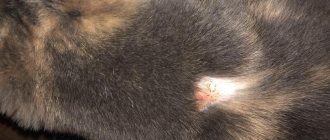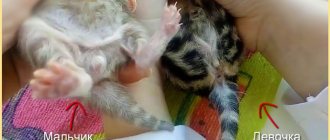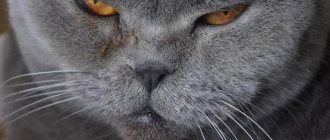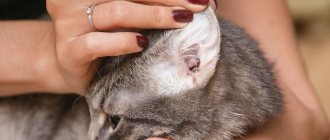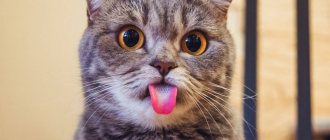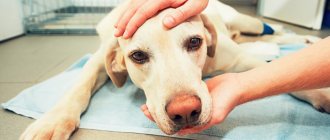Cat owners know that from time to time they have to collect cat hair around the house, as the period of natural hair loss begins. But why do some cats have too much fluffy cover, and even bald patches form near the tail or on the tummy and paws?
Severe hair loss is not normal ; you should definitely pay attention to it and seek advice from a specialist. But don’t be alarmed right away; perhaps the animal is lacking vitamins or this is how a skin disease manifests itself.
The veterinarian will diagnose why the cat’s hair is falling out and bald spots are forming, prescribe treatment, and explain preventive measures. If the cat sheds hair, but new hairs immediately grow, then it’s just shedding season .
Reasons for the appearance of bald spots in cats
Usually, due to illness or other physiological disorders in the animal's body, a bald spot remains on the neck, near the hind legs. Only after an examination at a veterinary clinic can the causes of baldness in cats be determined.
- Cat baldness can appear due to allergies to medications, certain types of food or products, or to hair care products.
- The fur sometimes peels off due to insect bites , but not all cat owners know about this. Flea bites may not go away without leaving a trace, although they are considered something minor.
- If your furry pet's back or other part of the body is peeling, this may indicate that the animal has experienced severe stress - fright, for example, or moving to a new place of residence.
- Among the causes of baldness are endocrine diseases, abdominal trauma, and pyoderma .
- Among the specific causes is feline symmetrical alopecia .
It is necessary to ensure that the cat does not lick the fur on its belly and paws too diligently and often; this can also cause damage to the hair follicles, their weakening, and hair loss.
Healthy coat and lack thereof
The second name for baldness is alopecia. The pathology is manifested by abundant hair loss of the pet, the formation of bare areas - bald spots. In a healthy state, cat fur is soft, shiny, silky, and the hairs fit tightly together.
Cats have fur replacement year-round. During certain periods, the shedding of hairs increases and the density of the fur decreases significantly - this is molting. If the shedding cat’s health is normal, there are no pathological formations on the skin, the nose is moist and cold, and the appetite is good, then there is no reason to worry.
Lack of hair can be congenital and not associated with pathology. The peculiarity is detected from 4 months of age and cannot be treated.
By origin, alopecia is:
- symptomatic – associated with a specific pathology;
- idiopathic - an independent disease.
The source of baldness varies:
- diffuse – the fur comes out abundantly and evenly;
- localized – a certain area of the skin goes bald;
- partial – bald spots appear in different places.
When a cat tears at itchy skin with its claws, infection can enter the wounds and an inflammatory process will begin.
Common types of hair loss in cats
An analysis of the location of bald spots on the cat’s body and the condition of the skin helps to make a rough diagnosis.
| pathology | symptoms |
| dermatological diseases | uniform baldness of the trunk and limbs |
| hormonal imbalances | the cat's tail at the base, chest, nose, hips goes bald, the skin becomes inelastic |
| thyroid pathology | fur grows abundantly on the neck, chest, belly, and pelvic area |
| stress | the cat begins to itch intensely, the back, inner thighs, belly, limbs, and anus go bald |
| avitaminosis | the body begins to become covered with medium-sized naked spots of a round shape, usually merging, the skin in the lesions turns red |
| oncological pathologies | large bald spots cover the lower body, belly, limbs, complete loss of hair is possible |
| fungal infection | In bald areas, cracking and peeling of the skin is observed |
Diagnosing the causes of baldness
In order to prescribe treatment for a cat and give its owner recommendations on maintenance, the veterinarian must determine why the bald spot appeared on the neck or paw. The cause is determined by exclusion; this approach requires professionalism from the doctor and attentiveness from the cat’s owner.
INTERESTING! If a problem with fur occurs, you need to carefully examine the cat, its fur and skin. If a cat that has hair on its hind legs has a rash elsewhere on its skin, either small or large, a diagnosis of allergic dermatitis may be possible.
With allergies, the pet owner may experience watery eyes, sneezing, and hair falling out in large clumps. The specialist will prescribe comprehensive treatment.
Such severe baldness is usually observed during an acute allergic reaction. Without eliminating the cause of the allergy, it will not be possible to cope with wool problems.
Features of treatment
You can eliminate bald patches in a cat above the eyes or in another problem area by addressing the root cause of the disease. If parasites are the cause of the skin disease, it is necessary to provide the pet with proper treatment. The use of special ointments, gels and sprays that effectively affect parasites will help improve the condition of your pet. The cat owner should give the animal vitamins that will increase its immunity.
If local baldness occurs as a result of allergies, then it is necessary to limit contact with allergens. A hypoallergenic diet will improve your cat's health. In this case, the veterinarian prescribes the animal to take antiallergic drugs and immunostimulants.
When an animal has problems with the endocrine system, then it is recommended to select special treatment. Taking hormones will improve the cat's health and return its coat to its previous appearance.
Baldness due to pancreatitis
It is difficult to imagine that a cat could develop bald patches due to chronic pancreatitis. This disease, even with a sluggish course, is accompanied by diarrhea, indigestion, fatigue and lethargy of the animal. Also, with this disease, the cat becomes bald on the back and other parts of the body.
ATTENTION! The presence of pancreatitis in an animal, due to which its fur on its tail, back, and between its hind legs is thinning, can be determined not only by frequent diarrhea, but also by rumbling in the stomach.
Diagnosis of alopecia in different parts of the body
Only a doctor can determine why a cat is going bald. The basis of diagnosis includes medical history, visual examination, and microscopic examination of hair roots.
The pet's blood is examined and a scraping is taken from the skin. If a tumor is suspected, an x-ray or ultrasound is performed.
The diagnosis is partially helped by the localization of bald spots on a cat:
- Symmetrical baldness of the abdomen, thighs, sides, and front legs is a characteristic symptom of a skin disease.
- Due to stress, cats tear out hairs in the anus, on the back, paws, stomach, and inner thighs. This happens especially often in the following breeds: Siamese, Abyssinian, Himalayan.
- Hormonal disorders are usually indicated by alopecia on the bridge of the nose, base of the tail, hips, and chest. The skin ceases to be elastic.
- In the case of a lack of thyroid hormones, pet hair is easily pulled out in the pelvic area, on the stomach, chest and neck.
- Cancerous formations provoke bald spots on the stomach, chest, and paws. Oncology can cause complete hair loss.
- Vitamin deficiency is characterized by the appearance of small, round bald patches, which can unite. The skin in places where there is no fur is bright pink.
- Fungal infections are characterized by the appearance of bald spots with scaly, cracked skin.
Scratching a pet's skin is dangerous due to infection and the development of an inflammatory process.
To make it easier for you to determine the cause of your pet's baldness, we have prepared a table. It contains all the main pathologies accompanied by hair loss in a cat:
Consequences of injury
Observing a cat after it has fallen and been severely injured, you will notice that it has also lost a lot of hair on some parts of its body. Sometimes injuries are visible and easy to diagnose, but they can also be hidden, which is even more dangerous.
Hair loss is sometimes the only visible symptom of internal injuries. Therefore, having detected the appearance of alopecia after a fall of a pet, you need to immediately report this to the veterinarian observing the cat.
Bald spots in combination with fearfulness and wariness quite accurately indicate the stress the cat has experienced. With this state of psychological health, the pet does not want to be handled, does not allow itself to be petted, looks for secluded corners, and may flinch from sharp and loud sounds.
IMPORTANT! As you can see, bald spots on a cat’s body always indicate some kind of health problem, so this symptom cannot be ignored.
The cat has lost hair on his belly
Recommended Posts
The cat's belly hair fell out, leaving only a short fluff. A “bald patch” has formed in the form of a triangle. The skin under the fluff is clean, pink, dense to the touch, there are two papillae on the sides. We noticed this about a month and a half ago, apparently he went bald at the end of summer.
The cat is 13 years old, no breed, neutered, not vaccinated, has not been ill with anything, active and cheerful, pees every day, poops once a week. We feed him all his life raw fish and meat, cucumbers, sometimes peas, etc., in the summer, grass from the street. Kitiket once a week. Doesn't go outside, only taken out a couple of times all summer.
“Yes, there is such an opinion among our brother. Not everything is so simple; very often even a good doctor underestimates diet therapy. In this matter I adhere to the opinion of BSAVA - the British Association of Small Animal Veterinary Medicine. This is, so to speak, a globally recognized brand of approach in global veterinary science.
Let me give you this example: So you give a cat a raw egg, a very healthy product, both proteins and fats and amino acids, but the egg contains avidin, which is killed by biotin, by the way, this can be the cause of baldness. Or you give your cat vitamin B1 and sea fish, such as cod, or just fish oil, which is healthy, but sea fish and fish oil contain the enzyme thiaminase, which simply breaks down vitamin B1. These substances are called antivitamins and are sometimes found in healthy foods. And the type of feeding that you use is called unbalanced feeding. In addition to antivitamins, many minerals compete with each other in the body, for example calcium with phosphorus, etc. The result of their mutual competition is a violation of bone mineralization in kittens, the so-called juvenile osteopenia of kittens.
Well, in the end, you must agree that those who advocate for straight women do not take into account that porridge and the whole list of that horror
Source
Problems with the endocrine system
Alopecia, caused by disturbances in the endocrine system of cats, is not so rare. The specific endocrine disease may vary. Additional symptoms of hypothyroidism are lethargy, sometimes obesity, and decreased body temperature.
With hyperfunction of the adrenal cortex, swelling appears. What bald cats look like due to the endocrine system can be seen in the photos of special sites about feline health; accurate illustrations will help owners quickly recognize the disease in order to begin its treatment.
One area of the body is going bald
Baldness in the area of the hind legs most often occurs with liver lesions.
If only one area is balding and there are no visible reasons for this, you should urgently consult a doctor for a full comprehensive examination.
Possible factors causing alopecia:
- allergic reaction to medications, food, dangerous contacts;
- damaged hair follicles;
- injuries;
- stress;
- failure of endocrine processes;
- liver diseases;
- avitaminosis.
Avitaminosis
For normal functioning, the cat's body requires a complex of vitamins.
For normal functioning, the cat’s body, like the human body, requires the entire complex of vitamins and minerals, and the lack of them provokes various pathological processes. A lack of vitamins of a certain group is manifested by specific symptoms characteristic of this particular pathology.
Alopecia
A lack of B vitamins in the body can cause periodic vomiting in a cat.
- Along with the main symptom, there is a disorder of the digestive system in the form of periodic vomiting.
- Signs of dysfunction of the nervous and muscular systems appear.
- The animal is weak, lethargic, has an unsteady gait, and a sharp loss of weight.
- Global deficiency of vitamin B1 is expressed by paralysis and convulsions.
- Eliminated by eating more raw meat, bone meal, and yeast.
- Among other things, replenishment is required through the use of special vitamin preparations.
- Deficiency of vitamins B2 and B5 is manifested by cracks in the mucous membranes, slower growth of babies, decreased heart rate and body temperature.
- Eliminated by consuming dairy products and foods of plant origin.
- A lack of vitamin B12 manifests itself in more serious complications such as constipation, urination problems, enlarged liver and spleen, and intestinal colic.
Help only under the supervision of a veterinarian.
Cirrhosis of the liver
Liver cirrhosis in a cat.
As a result, a malfunction occurs, and subsequently a complete failure of all functions of the organ. There are several reasons for the appearance of this pathology.
Primary factors
Primary factors are most often caused by gradual intoxication of the body and, as a result, a large accumulation of toxins in the liver. Another reason that led to cirrhosis is hypovitaminosis of group B. With this pathology, symptoms appear after some time, as a result of the action of some aggressive factor. Provoking factors are also the failure of metabolic processes and hereditary predisposition.
Lack of food containing B vitamins can lead to cirrhosis of the liver.
Secondary factors
Infectious or invasive diseases and pathologies of the cardiovascular system act as secondary aggressors.
Infectious diseases can cause cirrhosis.
Signs
- For a long time, the only sign of cirrhosis may be the pet’s baldness in the abdomen and hind legs.
- Further, as the disease progresses, the abdomen becomes enlarged, which may indicate ascites.
- The cat looks tired, shows apathy and aggressive reactions to any attempts at contact.
- Decreased appetite, weight loss, and severe thirst.
- Frequent urination.
- In the final stages, convulsions, loss of coordination, and decreased vision are noted.
An enlarged abdomen may indicate ascites.
Treatment and therapy
Treatment is aimed at maintaining the heart and stopping the progression of the disease. If you refuse to eat, force-feeding is used using a drip infusion of glucose solution. Vitamin therapy and diuretics are prescribed.
If you refuse to eat, feeding with a drip solution is used.
Endocrine focal symmetric alopecia
Like most pathologies, it cannot arise independently and there are quite a lot of provoking factors: hypothyroidism, hyperfunction of the thyroid gland, hyperfunction of the adrenal cortex, diabetes. As a rule, symmetrical baldness is not accompanied by itching, although in the presence of allergic reactions such a phenomenon is quite possible, but in very rare cases.
As a rule, baldness is not accompanied by itching.
Treatment
Treatment depends on the identified pathology and is applied strictly under the supervision of a veterinarian. The owner’s only comprehensive help is timely contact with a specialist.
Treatment should be strictly under the supervision of a veterinarian.
How to treat hair loss in cats
If a cat has a bald patch on its stomach, hind legs, tail, or if severe hair loss is noticeable, a veterinarian’s help is needed in solving the problem. If such a symptom is ignored, serious diseases can develop into a more complex condition of the animal .
The choice of means and methods of treatment depends on the diagnosis of the cause of the disease.
- Did the bald spot appear at the site of a flea bite? This painful area should be treated with an insecticidal agent. The doctor will recommend which one.
- If you have a food allergy, first eliminate the source of the allergic reaction. At the same time, the veterinarian prescribes antihistamines.
- You may also be allergic to dust, in which case you should do wet cleaning in the house more often, especially in those rooms where your pet spends time.
- If the cause of bald spots is chronic pancreatitis, without curing this disease it is impossible to restore the thickness of the coat. Treatment is aimed at eliminating pain, combating dehydration, and reducing destructive secretions. Swelling should be relieved and pancreatic function should be slowed down.
- In case of hyperthyroidism and hypothyroidism, first of all, it is necessary to restore the balance of thyroid hormones. Treatment of the first disease involves taking medications that also support the functioning of the kidneys and heart and inhibit the production of thyroid hormones. If hypothyroidism is to be treated, medications are needed to slow down the binding of serum proteins.
Only after restoring the balance of hormones can we expect the elimination of bald spots in a cat.
In the most severe cases, the veterinarian decides on surgical intervention. After surgery, the cat owner must feed her according to the prescribed diet, which includes foods with enveloping properties.
Treatment depending on the cause
Treatment for alopecia becomes effective once its causes are correctly identified. It will be possible to establish the pathological factors that caused the disorder only after a detailed diagnosis.
If the cat begins to go bald, you will need to decide what to do together with your veterinarian. Before prescribing a course of treatment, the doctor will conduct a thorough examination of the pet and conduct a conversation with its owners. The following diagnostic methods will help you make a correct diagnosis:
- taking hair roots from the patient for subsequent examination under a microscope;
- general blood test;
- scraping from affected areas of the body;
- ultrasound or x-ray examination of internal organs (if the cat is suspected of having tumors).
The subsequent fight against the disorder is aimed at eliminating the underlying disease that provoked the thinning of the coat.
Treatment for a cat that is going bald is not quick and takes a considerable period of time. For successful hair restoration, all procedures must be done in accordance with the recommendations of a veterinarian. If the process is started, it is quite difficult to return the animal to normal coat.
What to do about baldness caused by infections
If the infectious nature of the disorder is confirmed, cats are prescribed:
- antiviral drugs (Kanamycin, Ribaflox);
- antibiotics (Amoxicillin, Ceftriaxone).
When affected by the fungus that causes ringworm, a combination of topical and internal agents is necessary. Sanoderm ointment, Mycostop ProVET spray, Orungal tablets, Ketoconazole are indicated for animals.
For cheyletiellosis, the main emphasis is on the use of skin preparations. It is possible to destroy parasites that cause thinning of the coat with the help of Ivermek spray, Demos, Butox.
In addition to the main treatment, you will need to enrich the cat’s menu with vitamins and bathe your pet often. Cat dishes and accessories and all rooms must be thoroughly sanitized. When affected by parasites, animals are cut short.
Combating allergies and hormonal problems
First of all, in case of baldness of allergic origin, all irritants must be identified and eliminated. Animals are prescribed anti-allergenic drugs:
- antihistamines;
- steroids;
- preparations with vitamin B 7.
The problem of a hormonal nature is eliminated with hormone-containing drugs. If a cat is going bald due to tumors in the thyroid gland, surgical intervention is prescribed.
The cat's diet includes lean boiled meat, fish, quail eggs, cereals, and vegetables. To prevent infection by parasites or food poisoning, you should carefully handle food and ensure its freshness.
What to do when your cat goes bald from stress
Cats that are going bald due to increased anxiety are prescribed sedatives. It is possible to improve the emotional background thanks to the following drugs:
- "Stop the stress."
- Relax Plus.
- "Zoomir Antistress".
- Fitex.
It will be necessary to normalize the situation in the house, to eliminate factors that traumatize the sensitive psyche of the animal. The cat needs to be provided with toys and places where it could hide in case of fear or stress.
It is important for cat owners to know what to do to prevent alopecia. Prevention of pathology includes a balanced diet of animals, vaccination, and periodic use of antiparasitic agents. Careful hygiene of cats, a favorable psychological climate in the house, and no contact with sick individuals are required.
Other causes of bald spots and hair loss
Listed are the main reasons why a cat’s coat may most often thin out. But veterinarians, upon careful examination of the animal, can detect other sources of baldness.
The thickness of the coat in pregnant females changes, and problems with hair can also arise in diseases such as ringworm, solar and neurogenic dermatosis, folliculitis, acne, erythema multiforme .
ATTENTION! All causes are serious and self-medication is excluded. Even if the doctor sends the cat for treatment at home, he will diagnose and prescribe professional, effective treatment.
Prevention to prevent your cat from going bald
A flea and tick collar is a preventive measure to prevent your cat from going bald.
Hair loss is one of the symptoms of a deviation in the health of an animal’s body. There are preventive measures that will help the animal be healthy. So, in order for the pet to be healthy, the cat does not go bald, but is always beautiful and in a good mood, follow the following rules:
- Choose quality food . When choosing, consider the age and condition of the animal. For example, there is food for pregnant cats, kittens or cats suffering from certain diseases (therapeutic).
- Take antihelminthic courses every 3 months.
- Use flea collars. Also regularly treat cats with special drops against parasites (drip on the withers).
- Eliminate anything that may cause allergies.
- Be sure to vaccinate your animal.
- Brush and wash your cat regularly.
By paying close attention to your pet, serious illnesses can be avoided. Please note that some diseases that are accompanied by hair loss in a cat can also pose a danger to humans (for example, lichen or intestinal parasites). Therefore, be attentive to the health of your pet and if any ailments appear, consult a veterinarian. Good luck!
Preventive measures
Proper prevention often allows you to avoid problems with hair loss.
- You should carefully choose food for your pet, feed it not only dry food, but also high-quality homemade food (vegetables, dairy products, herbs). The diet should contain a lot of vitamins.
- Vaccination is required, taking into account the schedule for a specific breed.
- It is recommended to protect the cat from stress and injury and provide him with the best living conditions.
- Products for hair care and antiparasitic skin treatment are also needed.
Psychogenic alopecia
Hair loss in cats can be psychogenic in nature. That is, the cause in this case is obsessive behavior. For no apparent reason, a completely healthy, well-fed and well-groomed cat goes bald in a short time. With careful observation, the owner may notice some features: the cat is overly preoccupied with grooming procedures.
When a cat constantly licks, bites and pulls out fur, it not only violates the integrity of the coat, but also injures the skin. In bald areas, areas of redness, sores and sores may form. To get rid of the pain, the animal licks the injured areas even more, which only worsens the situation.
This behavior is called biased. If a cat is in a stressful situation for a long time, for example, he cannot catch a bird outside the window, or is limited in physical activity, he shifts the action to himself, as if he is self-soothing. The most common expression of biased behavior is “self-grooming.”
The reasons that cause psychogenic baldness can be very different:
- Isolation and limitation of physical activity.
- The appearance of a new member in the family - it can be a new pet or a newborn baby. The focus of attention shifts to the “new guy,” and this fact causes negative emotions in the cat.
- Separation from owner or family members.
- Repair or relocation.
- Boredom.
These problems can be avoided if you pay enough attention to the cat: play with it often, caress it, provide conditions for normal physical activity, and take care of its psychological comfort.
What to do when your pet is shedding
Each hair is “born” from a follicle, which is in a state of activity, forming the structure of the hair. When it grows, a resting phase begins; the hair does not lengthen, but remains in place. After 4-8 months, the hair dies and falls out. The peak of fur coat change occurs in the off-season.
Walking cats become warmer for winter, and before summer their fur coat becomes thinner. Pets can change the order of “changing clothes”: in the summer the air conditioners work in the apartment, and in the winter it becomes hot.
During this period, it is necessary to scratch the cat daily with a comb suitable for the type of fur; this will reduce the amount of hair left by the pet on furniture and carpets. Long-haired breeds (Persians, Maine Coons) develop mats without regular brushing. Cats try to keep themselves tidy and groom themselves.
Fur accumulates in the stomach, which the pet will regurgitate from time to time. To prevent a large accumulation of lumps in the gastrointestinal tract and problems with intestinal obstruction, you can give your pet special food that facilitates the removal of trichobezoars, phytomins, malt paste, or plant grass for cats in a pot.
Be sure to read:
What is pyoderma in cats, symptoms and causes of the disease
Examination by a veterinarian and diagnosis
The effectiveness of treatment depends on an accurate diagnosis. As mentioned above, you should definitely contact a special clinic. Prescribing medications yourself is very dangerous. From such “treatment” the cat may lose all its fur.
At the veterinary hospital, your pet will be able to undergo the necessary examinations. One of the main tests is a trichogram. Thanks to it, they receive information about the condition of the coat, making the first conclusions about the causes of the disease.
To care for a cat, you need to know what a furminator is for, whether cats need clothes, everything about mating cats, how to choose a comfortable carrier, whether you need to sterilize a cat, how to trim a cat’s claws, how to make toys for a cat with your own hands, how to give birth to a cat how to make a scratching post.
Did you know? Smuggling cats from ancient Egypt was punishable by death.
